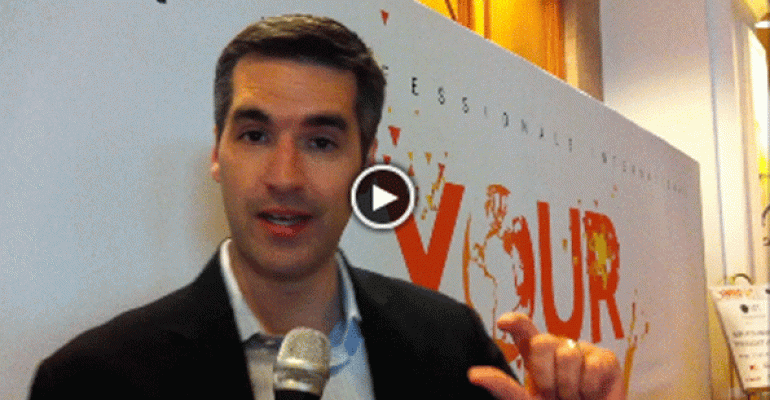Samuel J. Smith, an event technology consultant and president of Interactive Meeting Technology, shared some of what he learned as a researcher for The Meeting Professionals International Foundation’s Hybrid Meeting Project during a session at this year's MPI World Education Congress. Sponsored by Sonic Foundry, the researchers surveyed 1,800 people and conducted 37 interviews to find out how planners are using hybrid events.
His first tip: You should attend at least eight hybrid events. We’ve all been to probably hundreds of live events, so we know what that experience is from the attendee perspective. You have to do the same virtually if you want to develop the same understanding of the hybrid experience on the other side of the screen.
His next: Don't worry about the virtual component drawing off people who otherwise might attend IRL. While 50 percent of planners surveyed said they worried they would lose attendees by providing a virtual component, 67 percent said that they did not in fact have any change in attendance after going hybrid. Asked what happened at the next year’s meeting, 88 percent said they had no negative change, 23 percent said attendance went up, and 65 percent said it didn’t change either way.
The researchers also asked attendees why they attend virtually instead of going to the meeting:
- 55 percent said it was due to their travel budget
- 50 percent said they couldn’t afford the time out of office to go in person
- 45 percent cited cost as a factor
- 25 percent said they didn’t have enough lead time
- 20 percent watch preferred to watch the recording later
- 15 percent said they prefer virtual to live events
- 15 percent said they learned about the event as it happened and so had no way to get there
Interesting, isn’t it, that so much of the reasoning is because of time and money constraints? Sam said that they did in fact ask if they’d go if time and money weren’t factors, and the majority said they would. (Here's one reason why this might be.)
Don’t Underestimate the Importance of a Rehearsal
Sam couldn’t stress enough the importance of doing a rehearsal ahead of time to finding and fixing tech glitches, and walk everyone through both the technology and the process. And there are a lot of people involved, not just your presenters and you, but also your production company, your Internet provider, your streaming provider, and your platform provider. “Rehearsing brings all four of these vendors together,” he said.
Great tip for remote speakers: Use both front and back-facing lights, along with a soft light, to eliminate weird shadows on the speaker’s face. You can buy them on the cheap at Walmart, etc., and it can really make a difference in the presentation quality. A couple more tips: Have mics available for the audience questions, and ask them to stand up and look at the camera so remote participants can see and hear them too.
Manage Expectations
The remote experience will be different than what those in the room get, so set expectations accordingly. Attendees want content, but you have to make it interesting—i.e., interactive—so you don’t lose them to e-mail, he said. “You have to get the content right first, then format it to create two-way engagement…you have to structure the dialogue.”
You can have the presenter answer remote audience questions during the break while the in-situ attendees are off having coffee, he suggested. One way to get remote attendees’ attention is to use their names, “Say Bob from Iowa asked this question,” Sam said. “Not only is Bob happy to hear his name, but it also spurs others to ask questions so they can get recognized too.” (Note from me: This totally works in the hybrid sessions I’ve attended.) Send remote attendees something that helps them to connect with the other attendees and make it more real for them.
He also suggested that planners coach speakers to show they how to engage online attendees. “A lot of [subject matter experts] are boring,” he said. Use a talk show format (where someone interviews them) to make them more interesting.
The Bottom Line
As he mentioned earlier, there are four different types of vendors involved in a hybrid meeting, and production can get expensive. Having production and hard-line Internet in all those rooms adds up. And video production can get even more pricey in a union facility, he added. Those surveyed said that 42 percent of their budget went to video production, 31 percent was for streaming services, and 10 percent to the platform. He suggested trying to compare apples to apples as much as possible when looking at bids, and, especially for some more specialized industries (think pharma and financial services), you may want to be sure they have experience in your market. Get everything in writing, he advised. “They’re not trying to cheat you, but there can be misunderstandings…Ask questions if you don’t understand, and keep asking until you do.”
Weird fact: 10 percent of those who are most active on Wi-Fi were also livestreaming the session, whether in the session room itself or back in their hotel rooms. I wouldn’t believe it if I haven’t seen people sitting in sessions live-streaming that exact session, but I have. Not in this session though.
Anyway, all this and more is available at MPI’s Web site, including a summary of the study and a hybrid meeting toolkit that’s free to members ($199 for non-members). It's been around for a year or so, but it's well worth checking out if you haven't yet mastered the art of hybrid meetings.





